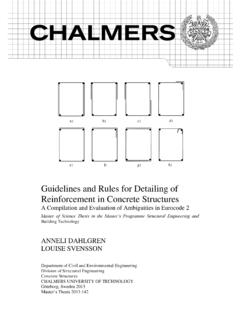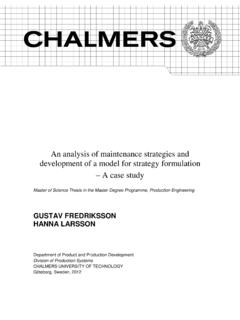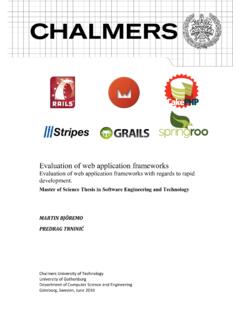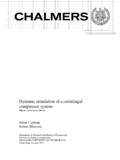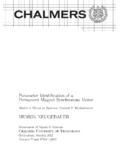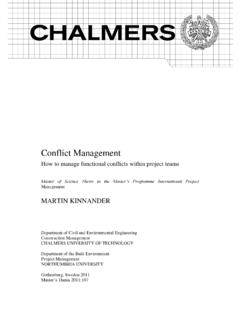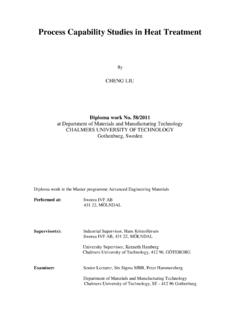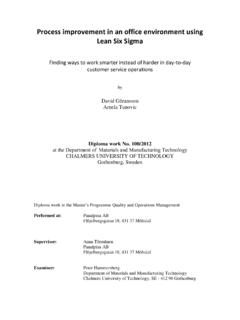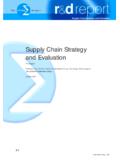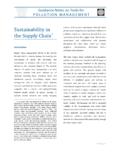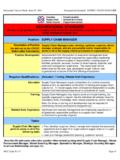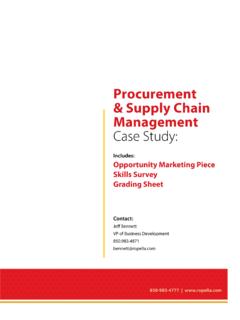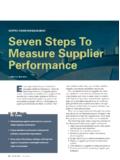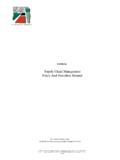Transcription of Measuring supply chain performance through KPI ...
1 Measuring supply chain performance through KPI identification and evaluation Master's thesis in supply chain Management and "Quality and Operations Management . NICLAS GAMME. MARTIN JOHANSSON. Department of Technology Management and Economics Division of Operations Management Report No E2015:109. CHALMERS UNIVERSITY OF TECHNOLOGY. Gothenburg, Sweden 2015. REPORT NO. E2015:109. Measuring supply chain performance through KPI identification and evaluation NICLAS GAMME. MARTIN JOHANSSON. Department of Technology Management and Economics Division of Operations Management CHALMERS UNIVERSITY OF TECHNOLOGY. Gothenburg, Sweden 2015 Measuring supply chain performance through KPI. identification and evaluation NICLAS GAMME. MARTIN JOHANSSON. NICLAS GAMME, MARTIN JOHANSSON, 2015. Report no E2015:109.
2 Department of Technology Management and Economics Division of Operations Management Chalmers University of Technology SE-412 96 Gothenburg Sweden Telephone +46 (0)31-772 1000. Printed by Chalmers Reproservice Gothenburg, Sweden 2014 Measuring supply chain performance through KPI identification and evaluation NICLAS GAMME, MARTIN JOHANSSON. Department of Technology Management and Economics Chalmers University of Technology Abstract supply chain management has become one of the most discussed topics in business literature and is by many organisations considered a key strategic element. Today, markets have become more dynamic with rapid changes in customer requirements. These rapid changes have increased the importance for companies to ensure that materials and information flow smoothly between the actors in a supply chain .
3 Being able to measure supply chain performance is important since it leads to a greater understanding of the supply chain and provides important feedback on the improvement progress. In spite of companies' and managers' recognition of the importance of supply chain management, they often lack the ability to develop effective performance measures and metrics. In addition, relatively little literature covering PMSs and the selection of performance measures in the context of supply chain management exists. The purpose of the thesis is to develop a structured framework for creating and evaluating supply chain performance indicators with the aim of facilitating organisations' efforts when Measuring supply chain performance . The theoretical framework, focusing on relevant aspects when Measuring supply chain performance , was formed and used in order to develop a new framework for Measuring supply chain performance .
4 To investigate the functionality of the framework it was tested in a case study at Swedish Match. The empirical data builds on eight interviews made with the head of each function within the Global supply chain department at Swedish Match as well as on documents and observations. The data consists of information regarding what measures Swedish Match is currently using, as well as how it categorise, and share these performance measures. The output after applying the framework at Swedish Match resulted in twenty-seven new measures divided into four different categories, measures taken directly from theory, measures defined by the researchers with inspiration from theory, measures from theory already in use at SM, and measures not suitable for Swedish Match. The result from the case study shows that the framework can be used to develop new performance measures.
5 However, before being properly implemented the success of the measures is uncertain. Keywords: supply chain management, supply chain strategy, supply chain performance , performance measures, performance measurement system, key performance indicators. I. Acknowledgement This thesis has been conducted during Spring 2015, by two students from the Master Programs supply chain Management' and Quality and Operations Management', for the Department of Technology Management and Economics, at Chalmers University of Technology. We would like to express our great thanks to our supervisor at Chalmers, Mats Winroth, for his continuous support during the work process of this thesis. With his experience and knowledge within the field he has provided us with invaluable academic input, as well as useful knowledge about industrial cases and phenomena.
6 We would also like to express our sincere gratitude to our supervisors at Swedish Match, Torbj rn kesson and Lousie Fr str m, for their confidence in us. They have provided us with inspiring thoughts and insights and invaluable information, which has lead us forward in the work process of this thesis. Finally, we would also like to thank all personnel at Swedish Match for taking time to answer questions, participate in interview sessions, and for making the time at Swedish Match enjoyable. Gothenburg, August 14. Niclas Gamme Martin Johansson II. Table of Contents 1. INTRODUCTION .. 1 Background .. 1 Purpose .. 2 Problem analysis .. 3 Delimitations .. 3 2. THEORETICAL 5 supply chain concepts .. 5 supply chain management .. 5 supply chain strategy .. 6 supply chain Collaboration.
7 10 Concept of Measuring performance .. 11 performance measurements .. 11 performance Measurement systems .. 12 performance measurement systems in a supply chain context .. 13 Verification and characteristics .. 17 Elements driving supply chain performance .. 20 Facilities .. 20 Inventory .. 22 Sourcing .. 25 Information .. 26 Pricing .. 27 Transportation .. 29 A new framework for Measuring supply chain performance .. 31 3. METHODOLOGY .. 35 Research strategy .. 35 Research Process .. 36 Literature review .. 36 Case study .. 37 Data collection .. 37 Data Analysis .. 38 Research Quality verification .. 40 Validity .. 40 Reliability .. 40 4. EMPIRICAL STUDY .. 43 Corporate Background .. 43 Global supply chain function .. 44 Gothenburg Factory .. 46 Kung lv Factory .. 47 Procurement.
8 48 Planning & Logistics .. 50 Business Control .. 51 Engineering & QA .. 52 Business & Operations Support .. 52 Current performance measures at GSC .. 52 Gothenburg Factory .. 53 Kung lv Factory .. 56 Procurement .. 59 Planning & Logistics .. 61 Business Control .. 62 Engineering & QA .. 63 III. Business & Operations Support .. 64 5. ANALYSIS .. 65 Step one Corporate strategy evaluation .. 65 Step two- supply chain strategy evaluation .. 65 Step three- Selecting and categorising performance measures .. 67 Facility .. 67 Inventory .. 69 Sourcing .. 70 Information .. 71 Pricing .. 71 Transportation .. 72 Step four- Host company PMS evaluation .. 73 Global supply chain .. 74 Factory .. 75 Production .. 75 Procurement .. 76 Planning and Logistics .. 77 Business Control .. 77 Engineering & QA.
9 78 Business & Operations support .. 78 Information sharing at SM .. 78 Step five- Comparison of measures from step 3 and 4 .. 80 Step six- Verification of performance measures characteristics .. 85 6. 89 7. CONCLUSION .. 91 Reference list .. 95 IV. Table of Appendices Appendix A Measure Definitions .. iii Appendix B Interview xiii Appendix C Product formats and xv Table of tables Table 2-1 Functional versus Innovative products: difference in demand (Fisher, 1997).. 7 Table 2-2 Physically efficient versus Market-Responsive supply Chains (Fisher , 1997).. 8 Table 2-3 Attributes affecting overall implied demand uncertainty (Chopra and Meindl, 2013).. 9 Table 2-4 Key elements related to strategic goals (Beamon, 1999) .. 13 Table 2-5 The POA Metrics board (Chan & Qi, 2003).
10 15 Table 2-6 List of recommended Characteristics for a PMS (Neely et al., 2000).. 17 Table 2-7 Characteristics needed for a successful PMS (Beamon, 1997).. 18 Table 2-8 Extended Characteristics criteria's for a PMS, with added characteristics from the authors.. 19 Table 2-9 Explanations and definitions of the different formulas used to calculate OEE (Muchiri & Pintelon, 2008).. 21 Table 2-10 Facility 22 Table 2-11 Inventory measures .. 24 Table 2-12 Sourcing measures .. 26 Table 2-13 Information measures .. 27 Table 2-14 Pricing measures .. 28 Table 2-15 Transportation measures .. 30 Table 4-1 QDE step components with their respective definition and formula .. 53 Table 4-2 The Gothenburg Factory QDE-STEP-table Long Range Plan.. 54 Table 4-3 The Gothenburg Production QDE-STEP table Long Range Plan.
